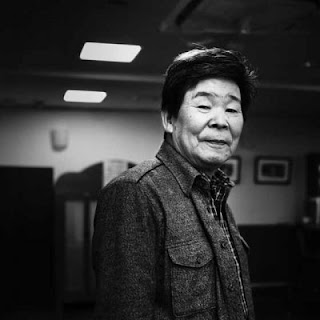Wired.uk spoke to Isao Takahata recently, touching upon his insights gained from a revolutionary 50-year career. The interviewer, Matt Kamen,, to my pleasant surprise, knew his subject's work, and brought up the 2003 anthology movie, Winter Days, in which Paku-San contributed a scene. That was very nice; Winter Days is one of those animated movies championed by animators and artists, playing in museums and festivals on a regular basis. Instead, it remains almost completely unknown outside of Japan. I guess it doesn't fit within the established genres of "Anime," "Disney," or "Pixar." That needs to change.
Takahata also comments on the freewheeling, impressionist art style of Princess Kaguya, which first emerged in his 1999 feature My Neighbors the Yamadas (and a number of Studio Ghibli short films), and was very strongly influenced by the films of the late, great Frederic Back.
Kamen speaks of Kaguya as Takahata's "final" movie, and this is a common mistake, probably owing to Hayao Miyazaki's retirement from feature films. Paku-san has never announced any retirement; indeed, he has recently spoke about future film projects he might pursue. Will those plans come to fruition? It's hard to say. The clock's ticking, in any event, a fact that Paku-san will happily point out.
Here are the key segments from the Wired.uk interview:
Between My Neighbors the Yamadas in 1999 and The Tale of the Princess Kaguya, you were involved with Kihachirō Kawamoto's Winter Days anthology. It's probably your least known work in the west, so could you discuss how you became involved on the project?
Winter Days is a collection of collaborative linked poems hosted by BashōMatsuo, the renowned seventeenth century haiku poet. Creating renku, collaborative linked poems, is a highly cultured amusement in which several people take turns composing extemporaneous short, linked poems to jointly create a long poem. Humour was an essential aspect of this form of haiku, or the playful form known as haikai.
Kihachirō Kawamoto, to whom I owe much, came up with the idea of creating a film of Winter Days by assigning each poem to a different animation director to realise this project. He asked me to participate in this effort. I thought this was a rash attempt, but I wanted to applaud Mr Kawamoto's foolhardiness as he knowingly took this on. I first cooperated with Mr Kawamoto in turning the old and difficult language of the linked verse collection into modern Japanese. This was distributed to the participating animation directors. While we were working on this, from the expectations I had and respect I felt for mutual friends of ours, the Russian Yuri Norstein and the Canadian Frédéric Back, I decided to take on one of Bashō's haiku. Unfortunately, Mr. Back was unable to participate as his schedule was too busy.
The result was a unique and interesting film. But, unless one understands the meaning of each poem, it might be hard to comprehend. I was especially impressed by Mr. Norstein's segment in which he showed such a Japanese poetic sentiment and humour, far beyond what Japanese people can express.
Visually, The Tale of the Princess Kaguya is closer to Yamadas than your earlier movies. What appeals to you about this more impressionistic style?
It is interesting that you describe the style as impressionistic! I have been strongly influenced by Back's Crac!and The Man Who Planted Trees. His animation style can truly be called impressionistic.
In order to have people believe in a fantasy world and characters that no one has seen in reality, it may be best to present the space, objects, and characters in a three-dimensional manner. It is as if that world existed right there, in a trompe l'oeil fashion. The current American animation films utilise 3D CG to aim in that direction.
But I wonder about the representation of the world we know well, how to depict very ordinary daily landscapes, nature, and people. I have long thought that it is better to appeal to the viewers' memory and imagination but this was impossible to express through animation. The initial act of sketching has been the best method for carving onto people's minds and memories the true impression of objects and figures.
Convinced that it was unnecessary to draw in scrupulous detail the everyday world that everyone knows, I used this style forMy Neighbours the Yamadas. I thought that the gifted Hisaichi Ishii [creator of the manga Nono-chan, thatYamadas was based on] had captured a distinct reality of Japanese people in his graphic renditions, and I believe I made the characters move with greater reality than in the usual animation films.
How did you apply those techniques and styles to The Tale of the Princess Kaguya?
With [this film] I went further along this direction to have the audience vicariously experience the instant the artist rapidly sketched what was occurring in front of his eyes. I aimed to have the audience vividly imagine or recall the reality deep within the drawings, rather than thinking the drawings themselves were the real thing. This would allow the viewers to feel moved by the actions and emotions of joy and sorrow of the characters, and sense nature teeming with life, in a more evocative way than through a seemingly real painting.
For this effort to succeed, it was essential to have the collaboration of a brilliant animator and an artist with special talents. Without Osamu Tanabe, who created the character design, animation design, and layout, and Kazuo Oga, who created the artwork, "The Tale of The Princess Kaguya" could not have been made. This work is the crystallization of the efforts of these two and the entire staff who supported our vision.


No comments:
Post a Comment